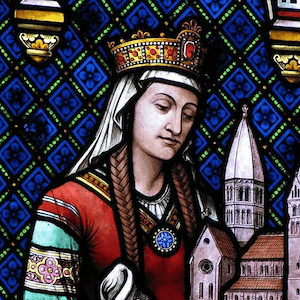
St Hildegard of Bingen (1098-1179) was a German Benedictine abbess, mystic, composer, philosopher, physician, and polymath who became one of the most remarkable figures of the medieval period. She composed liturgical music and researched herbal medicine.
Read the full St Hildegard of Bingen novena on the novena page. You can also learn more about novenas here.
What Is St Hildegard of Bingen Known For?
Born into a noble family in the Rhineland, Hildegard experienced mystical visions from childhood. At age eight, she was sent to live with an anchoress named Jutta, who taught her to read and write. When Jutta died in 1136, Hildegard became the leader of their small religious community, eventually founding her own abbey at Rupertsberg near Bingen.
Hildegard wrote theological works, natural history, medicine, and musical compositions. Her most famous work, Scivias (Know the Ways), describes 26 religious visions in vivid detail. She also wrote Physica and Causae et Curae, groundbreaking medical texts that combined spiritual and physical healing approaches.
As a composer, she created a substantial body of liturgical music, including the morality play Ordo Virtutum. Her musical style was distinctive and innovative for its time.
Hildegard corresponded with popes, emperors, and other powerful figures, offering spiritual counsel and sometimes sharp criticism. She undertook preaching tours across Germany, unusual for a woman of her era.
She was canonized by Pope Benedict XVI in 2012 and declared a Doctor of the Church, recognizing her profound theological contributions.